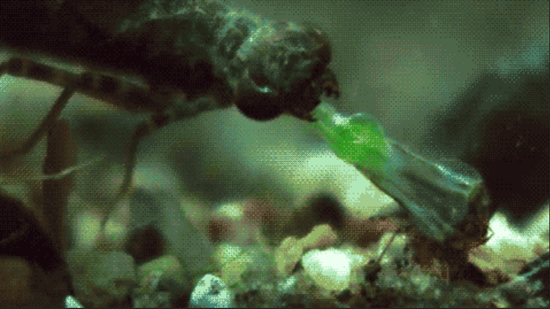
All insects possess the same fundamental body plan: A head, a thorax, and an abdomen. It is a testament to nature's twisted creativity that some of the grossest body parts in the animal kingdom can be found bursting, curling, and wiggling from these segments. Here are the 10 most repulsive insect body parts of all.
10. Trap-Jaw Mandibles (Trap-Jaw Ants)
Mandibles are pretty gross. And the grossest of all belong to the trap-jaw ant. This tiny little insect can snap its mandibles closed somewhere in the range of 35 to 64 meters per second (~78-145 miles per hour). In 2006, researchers at UC Berkeley used high-speed videography to determine that a trap-jaw's mandibles can accelerate at 100,000 times the force of gravity, and exert a force powerful enough to send its body soaring through the air in a defensive manoeuvre known as an "escape jump" (seen above). The average duration of a trap-jaw clamp is just 0.13 milliseconds, making it among the fastest predatory strikes in the animal kingdom.
9. Over-/Under-Water Eyes (Whirligig Beetles)
At first glance, members of the Gyrinidae family of water beetles (aka "whirligig beetles") appear to have four compound eyes. In fact, these insects - which inhabit the surfaces of ponds and streams - have two eyes, each of which is split into overwater and underwater parts. Last year, researchers led by Vladimir Katanaev of the Russian Academy of Sciences' Institute of Protein Research analyzed the micro- and nano-structure of the split eyes of two genera of whirligig beetle and found the surfaces of the over- and under-eye sections to be very different from one another:
...corneae of the overwater ommatidia are covered with maze-like nanostructures, while the corneal surface of the underwater eyes is smooth. We further show that the overwater nanostructures possess no anti-wetting, but the anti-reflective properties with the spectral preference in the range of 450–600 nm. These findings illustrate the adaptation of the corneal nanocoating of the two halves of an insect's eye to two different environments.
8. Donal Trump Wig (Asp Caterpillars)
Lots of caterpillars are covered in spiky, spiny, colourful, and otherwise intimidating body parts, but my favourite form of predator deterrence belongs to the asp caterpillar (Megalopyge opercularis), aka "the southern flannel moth." Not only is the asp caterpillar regarded as the most highly venomous caterpillar in North America, its furry coat bears an uncanny resemblance to Donald Trump's wig. But M. opercularis' mane is actually comprised of sharp spines. "The spines are connected to venom gland cells, and function like little hypodermic needles," writes Wired's Gwen Pearson. "The pain from injected venom is said to be intense, and lasts at least 12 hours."
7. Butt-Fireworks (Planthopper Nymphs)
Upwards of 12,500 species of insects are classified as planthoppers (infraorder Fulgoromorpha). Many of them (MANY) look like they're shooting roman candles out of their butts. The sparklers, it turns out, are made up of wax, which nymphs are hypothesized to extrude for a variety of reasons.
6. Blood-Slurping Bendy Straw (Mosquitoes)
If the blood-draining kit of a mosquito strikes you as a bland addition to a list of gross insect parts, you obviously aren't familiar with the freakishly flexible mouthparts of Anopheles gambiaea, a major vector of malaria in West Africa. What looks like a single blood-sucking apparatus actually comprises six distinct mouthparts: A pair of mandibles, a pair of maxillae, a saliva-injecting hypopharynx and a bloodmeal-siphoning labrum. This video, captured by researchers in 2012, shows what happens when a mosquito taps into one of its host's blood vessels. (Fascinating/awful/terrifying fact: Mosquitos infected with malaria-inducing parasites spend more time probing for blood vessels than their uninfected counterparts.)
5. Alien Jaws (Dragonfly Nymph)
Actually, the grabby-grab mouth parts found on dragonfly nymphs aren't jaws at all. What you see here is a "labial mask," which the dragonfly nymph uses in concert with its anus (!) to acquire food. Here's Gwen Pearson, entomologist and Wired's resident bug expert:
The ability of a dragonfly nymph to successfully snatch and grab food is directly related to its anus. The mouth-grabber (labium) is hydraulically activated. The dragonfly draws water in through the anus, clenches, then compresses its abdominal and thoracic muscles against the water-filled rectal chamber. This raises the internal body cavity pressure, and pushes the labium out - in a strike that takes 10 to 30 milliseconds.
4. Leg Gears (Planthopper Nymphs, Again)
Many planthoppers possess small bumps on their trochanters - the points on their undersides where their two hind legs connect to their bodies. Recently, researchers Malcolm Burrows and Gregory Sutton from the University of Cambridge observed that these bumps actually comprise the teeth of a high-speed, one-directional gear system:
"This is to our knowledge the first time that proper, engaging, counter-rotating gears have been seen in the animal kingdom," says Sutton. Crocodiles have cog-like teeth in their heart valves, and the wheel bug and cog-wheel turtle have teeth on their shells. But none of these structures actually act like gears. "You never see one cog-wheel turtle sidle up next to another, engage their shells, and spin in opposite directions."
Planthoppers appear to lose the bumps when they become adults; Burrows and Sutton hypothesize that planthopper nymphs use them like training wheels - only, instead of learning to balance on a bike, nymphs use their gears to learn how to better balance the propulsive forces of their rear legs.
3. Rupturing, Wing-Mounted Baby Sacs (Giant Water Bugs)
Photo Credit: Alex Wild
A family of insects known colloquially as "giant water bugs," Belostomatinae are notable for their size, their flood-fleeing tendencies, and their eggs, which are typically laid on the wings of males and carried there until they hatch. Some of the eggs on the back of this water bug have hatched and guys I'm sorry but that's all I can really say about this because looking at this photo is making me physically uncomfortable. Seriously. The person beside me at the cafe I'm working at just made this face and left.
2. Pheromone-Laced Party Horns (Moths)
Coremata (from the Greek for "feather duster") are the eversible, tubular organs found in the abdomens of some species of male moths. A type of "sex scale," coremata are covered in pheromone-releasing glands that are useful for picking up lady moths. Pairs hilariously well with party horn noises:
1. Head-Ball...Peduncle...Things (Brazilian Treehopper)
Photo Credit: Patrick Landmann
Another treehopper! This one is the Brazilian treehopper Bocydium globulare. The fuzzy balls projecting from the top of this insect's head-stalk aren't eyes (for that, see stalk-eyed flies), but teeny-tiny spheres of chitin. What those spheres of chitin do, however, is unclear. Here's Jerry Coyne:
A first guess is that it's a sexually-selected trait, but those are often limited to males, and these creatures (and the ones below) show the ornaments in both sexes. [Art Historian Martin Kemp, an expert on visualization in art and science] hypothesizes-and this seems quite reasonable-that "the hollow globes, like the remarkable excrescences exhibited by other treehoppers, probably deter predators." It would be hard to grab, much less chow down on, a beast with all those spines and excrescences.
Note, though, that the ornament sports many bristles. If these are sensory bristles, and not just deterrents to predation or irritating spines, then the ornament may have an unknown tactile function.
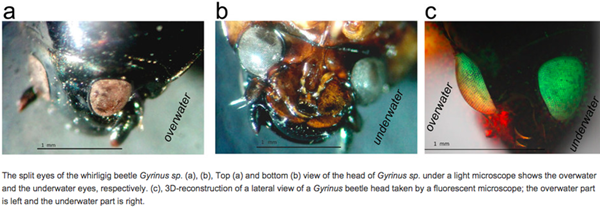
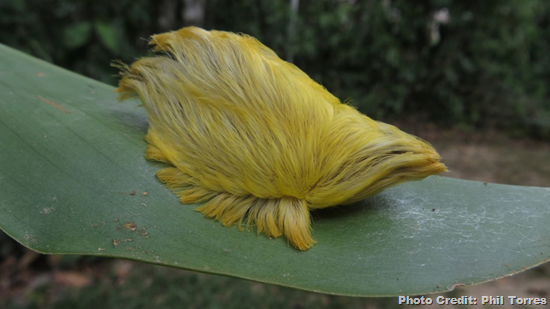
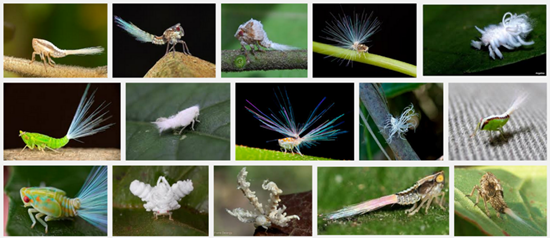
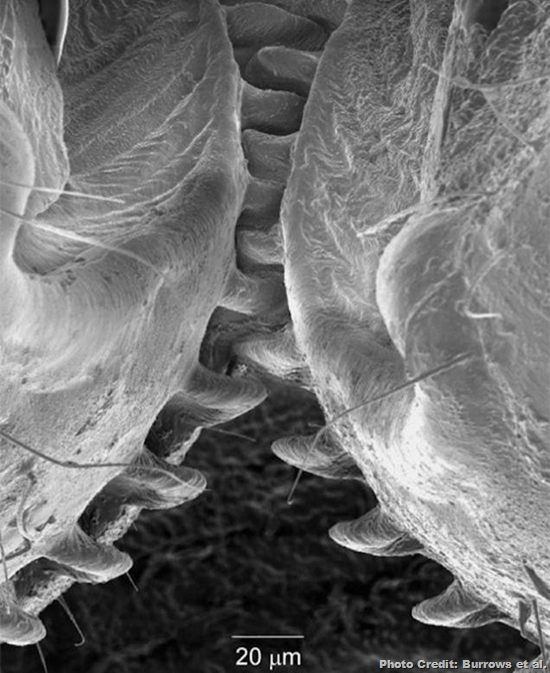
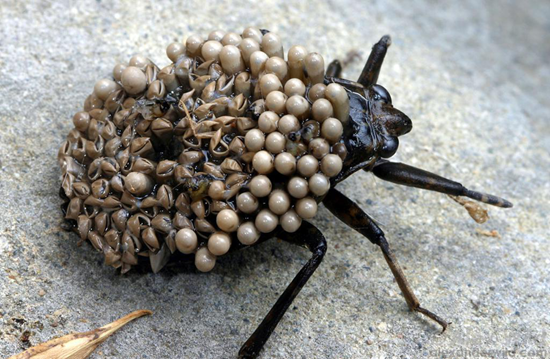

No comments:
Post a Comment
Please adhere to proper blog etiquette when posting your comments. This blog owner will exercise his absolution discretion in allowing or rejecting any comments that are deemed seditious, defamatory, libelous, racist, vulgar, insulting, and other remarks that exhibit similar characteristics. If you insist on using anonymous comments, please write your name or other IDs at the end of your message.